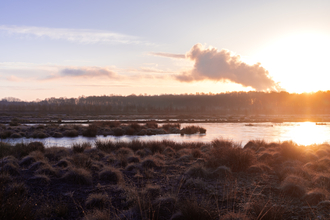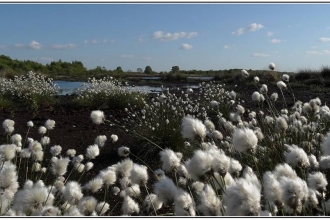Cadishead Moss is healing nicely after we rescued it from peat extraction
The Chat Moss Project
Restoring Manchester's mosslands before it's too late
Chat Moss is in trouble. Once a huge expanse of lowland raised bog dating back 10,000 years, this fascinating habitat is now barely clinging on.
What happened to Chat Moss?
The construction of the Liverpool to Manchester railway in the 19th century was the beginning of the end for Chat Moss. It ran right through the mossland, where peat was extracted and sent along the railway to Manchester. The same carts brought back the night soil of the sprawling metropolis to be spread on the moss, creating a fertile land that would grow almost anything... with enough drainage. The moss was destroyed; agriculture and peat extraction had made it a very human landscape.
So what's left?
Today, just 2% of the lowland raised bogs across Lancashire, Greater Manchester and North Merseyside remain in some sort of salvageable condition. Many are in a poor state and almost half of these sites are still being worked for peat extraction.
We are working desperately to protect these hugely valuable fragments and restore them to living, breathing mosslands once more

Astley Moss
Once abandoned and overtaken by woodland, Astley Moss is being transformed into a wonderful mossland reserve thanks to the dedication of our staff and volunteers. We are continuing to stabilise the water levels and encourage a wider variety of bog plants to grow, and it won't be long until the reserve is well on its way to full restoration.
A healthy bog on Cadishead Moss
Cadishead and Little Woolden Moss
Sitting right across from each other, Cadishead Moss and Little Woolden Moss have the potential to create one big mossland corridor where wildlife can flourish.
On Cadishead Moss, we have created a diverse mix of deep and shallow pools using the ditches and bunds left by peat extractors. Snipe are thriving while cotton grasses and mosses are recolonizing. Little Woolden Moss is also healing, but slowly, as we block the drainage ditches and level the bare peat surface on a grand scale.
How are we restoring Chat Moss?
The Chat Moss Project aims to restore lowland raised bogs in the Chat Moss area and engage local communities with this fascinating habitat.
We are developing a matrix of reserves and wildlife-rich mosslands which will connect with other bogs and wetlands in the Greater Manchester area, creating a Living Landscape for people as well as the wetland species in rapid decline.
We are also engaging local people and volunteers to raise the profile of Astley Moss, Cadishead Moss and Little Woolden Moss, and to assist the Trust with the management of these reserves. This management includes making much-needed access improvements which will help us run a range of programmes to get people out onto the mosses and appreciating their unique wildlife.
From volunteer work days, presentations and guided walks to wildlife surveys and activities for children, we want everyone to know just how special the mosslands on their doorstep are, and how desperately they need our protection.
How you can help
We need your help and support to continue our vital work on Chat Moss. You can help us shape the future of these mosslands:
Go peat-free
Try a peat-free alternative for your potting compost. You can find out more about going peat-free here.
Attend community events or practical work parties
Check the Friends of Chat Moss Facebook page and our own events page to find fascinating days out and fun activities that will immerse you in the landscape and wildlife of Chat Moss. You could also register to become a volunteer and join one of our regular practical conservation days to help us restore these mosslands.





